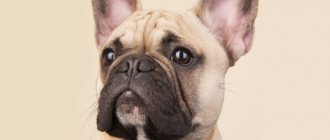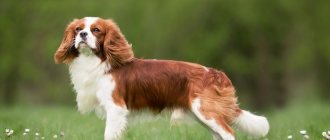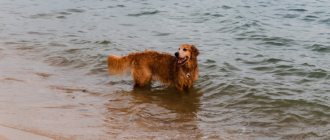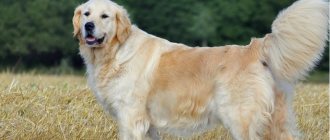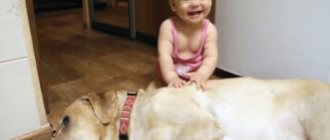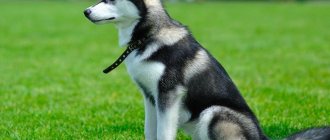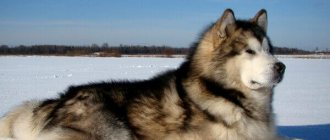Labrador is a carefree, cheerful fellow with an easy-going character. The full name of the breed is Labrador Retriever. The dog belongs to the group of gun dogs and is characterized by the following features:
- stable psyche and balanced character;
- versatility of use - the dog can be a guide, hunter, companion and even a nanny;
- loves to swim and has a strong physique;
- has webbed paws, thanks to which the dog does not get tired in the water and moves quickly;
- they are distinguished by a special structure of the rear part of the body, which allows them to jump far;
- The labrador's tail, wide at the base, is similar in structure to the tail of an otter; in water it works like a rudder;
- in the apartment, the pet sweeps away small objects around itself with its wagging tail;
- The dog's coat is adapted to long-term swimming, it is multi-layered and has thin layers of fat;
- has a so-called soft mouth, does not squeeze objects with its teeth, transferring them into its mouth;
- obedient, excellent interaction with the owner or trainer during classes;
- has good health, but there are problems with the hips, knees and joints, and there is a genetic eye defect.
Labras are full of life and are always ready for both work and play. These are sprinting dogs. On land they move at a speed of 20 km per hour. They swim twice as fast as ducks, reaching speeds of up to 5 km per hour in the water. The Labrador's record jump is more than 8 meters.
What does a pet need?
Labradors have topped the list of most popular breeds for a number of years. As dog experts explain, these dogs are chosen for their innate love for people. In order for a playful puppy to turn into a family pet, it will be necessary not to scare, but to provide the dog with a comfortable stay in the house.
Labrador Retrievers are dogs with endless amounts of energy, making them great pets for active families. But if puppies don't get enough exercise, they can quickly become bored. This often leads to destructive behavior in the Labrador - unmotivated barking, chewing foreign objects, destroying furniture, armchairs, and chairs.
Rules for communicating with a pet:
- walk for at least one hour;
- play actively with the dog;
- explore new streets, neighborhoods, squares, parks.
If the puppy lives in a private country house, it must be physically stressed. He needs daily jogging, training, and overcoming obstacles. By finding the right use of your pet's activity, you can get an affectionate creature.
A Labrador in an apartment needs walks even more than a dog that plays in the garden during the day.
This is interesting: Features of keeping a Labrador outdoors during the cold season
Active outdoor training should take more than 60 minutes.
In addition to training, you need to consult with veterinarians and choose a balanced diet for your baby. Considering that a dog’s body develops in stages, nutrition is selected individually for different ages. If a young puppy eats food that does not contain enough calcium, this risks rickets and other extremely unpleasant ailments. On the other hand, when an older dog does not receive enough vitamins, chronic diseases will develop faster. The pet must be regularly brought in for a medical examination; a specialist will be able to determine whether a particular food is suitable for a four-legged friend.
Origin story
The birthplace of Labradors is the island of Newfoundland in Canada. The history of the breed is shrouded in mystery and speculation. Exact information has not been preserved. It came to Europe at the beginning of the 19th century. In fact, this is a smaller copy of the black Newfoundland, created in order to get fish out of the water that have fallen off a hook or escaped from a net. The dogs also hunted birds with the same success.
Since the name "Newfoundland" was already taken, the breed was given the name "Labrador". The word "labrador" is translated as "worker". Representatives of the breed are truly hard-working. This is not the only version. It is believed that the name comes from the black labradorite stone, or from the Portuguese village of Castro Laboreiro, where dogs similar to Labradors are found.
Today it is the most popular breed in the United States. Labras serve in the police and customs. They work as guides and take part in the rehabilitation of patients. But most of them are just pets.
How to accustom to a home environment?
Caring for a young Labrador puppy is more of a pleasant daily chore than a dull procedure. The main thing is to organize a space at home in which the small pet will be “in its place.” This is his abode, it is inviolable. Children should not play there; its corner should not be moved around the apartment. The same goes for food. It is important to leave a container of clean water in the house during the absence of people; it should be changed 2 times a day.
Expert opinion
Anna Abramenko
An avid dog lover. Experience in veterinary medicine since 2009.
Ask a Question
Many owners, when leaving for work, leave a bowl of food and water, worrying that their pet will starve. This is absolutely impossible to do.
Not only can a dog make a mess, but he also risks harming himself. If food particles get into the water, the fermentation process may begin. The Labrador Retriever drinks a lot, often. In the absence of clean liquid, it will look for any. Acidified water can become a source of poisoning. And this is another visit to the veterinarian, which is not only financially expensive, but also a lot of stress for the pet.
Read the article: Life expectancy of Labradors at home
Possibility of being kept outdoors
Experienced dog breeders and veterinarians unanimously say that keeping a Labrador on the street is absolutely not harmful.
The breed is able to adapt even to severe cold or unbearable heat. For information. Breeders still recommend placing your pet in a house, since without attention and affection the dog will simply waste away.
If there is no other option and it has been decided to organize a home for your pet in the private sector, that is, in the yard, it is very important to take care of the dog constantly and give it maximum attention. It is strictly forbidden to move a dog from home to street or vice versa. These manipulations will cause stress in the dog and may even lead to illness.
Many people are interested in how to care for a Labrador if he lives on the street. First of all, it is important to understand that this dog is not suitable for being kept on a chain. The best option is a spacious enclosure with an insulated booth.
Being kept on chains has a negative impact on the psyche
Toilet training
To avoid unpleasant surprises, a 2-month-old purebred puppy must be walked every 2 hours. The main thing is to wait for the dog to relieve itself, and only then take it home.
Later, when the dog grows up, the periods between walks need to be increased. By the age of six months, the pet can safely go outside 2 times a day.
Expert opinion
Anna Abramenko
An avid dog lover. Experience in veterinary medicine since 2009.
Ask a Question
You need to feed your dog after a walk, not before it. A well-fed animal will not run actively, which means it will not receive the necessary physical activity.
Adult dog diet
Nutrition and care for your Labrador are very important. An adult dog is fed either natural food or ready-made dry food. Two meals a day are expected at certain times, since discipline is very important for representatives of the breed.
Animals are very energetic, so they should be provided with a sufficient amount of protein food to be active. The diet includes offal, as well as greens and boiled vegetables.
It is very important to feed your dog properly
Advantages and disadvantages
When a large dog lives in an apartment, you can really evaluate the pros and minor disadvantages of keeping it.
Positive sides:
- the need to lead an active lifestyle (moreover, a restless breed should be abandoned if this is a disadvantage);
- Dogs of this color get along well with children, are positive, and socialize quickly.
Flaws:
- Labradors shed heavily;
- the need to create a stable schedule.
Possible diseases
Dogs of this breed can be carriers of the following hereditary diseases that arose during the breeding process: diseases of the eyes, bones and joints. Some people experience dysplasia of the hip and elbow joints, which appears due to improper care of the baby.
Dysplasia occurs from an excess of calcium, phosphorus or due to obesity. Retinal atrophy - loss of vision in the dark or complete loss of vision, occurs due to heredity or can be acquired.
On average, pets live about 10 or 12 years. For a dog this is a relatively short period of time. Short life expectancy is also associated with a susceptibility to cancer.
Creating a Safe Environment
To prevent your dog from harming itself, it is important to initially prepare for keeping it in the house. When a puppy of 2 months appears in a new family, its natural curiosity can play a cruel joke on it. Such a baby still does not understand what can be chewed and what cannot be chewed. The task of all family members is to control so that the dog cannot get medicines, chemicals, or needles. This is the minimum list of things that will have to be monitored daily.
Those items that may be harmless for children (shampoo, toothpaste, soap, washing powder) are dangerous for the young body of a Labrador. Retrievers are naturally curious and constantly explore their surroundings. Certain changes must occur in the home environment; it is advisable to move all items dangerous to the puppy into higher boxes, first aid kits first.
This is interesting: Stages of development of Labrador puppies up to one and a half years old
Lifespan
So how long do Labradors live? Statistics show that the average life expectancy of dogs of this breed is 10-12 years, which is the average for dogs. For comparison: bulldogs live 8-10 years, pugs - 12-15 years, huskies and German shepherds - up to 15 years. French lap dogs show the maximum average life expectancy of 17.5 years.
The record for longevity among dogs, according to Wikipedia, still belongs to Labradors: the dog Chilla from Australia lived to be 32 years old, which by human standards is equivalent to 150 years.
Walking
Daily walks are not just a pleasant time spent with your pet in the fresh air before and after work. This is daily work, systematic training. At home, dogs are often very bored and their muscles stagnate. This is especially true for Labradors. Given their natural energy and temperament, a leisurely walk in the park is more likely to harm the dog than to help him exercise.
Many people often think of dog training as fun and believe that it is enough to just teach your pet to sit, give a paw, or fetch a stick. But adjusting the animal's behavior is also part of training.
When performing daily exercises, it is important to teach your four-legged friend basic skills, namely how to behave with guests, how to react on the street when the owner fastens the collar, and how to behave in the presence of children. It is these problems that are solved during the daily interaction of the dog with the owner.
The characteristics of the breed dictate the behavior. Most Labradors really love to learn. It is useful to take advantage of the innate learning ability by starting to train the dog as soon as the puppy has adapted at least a little to the house. You can work on basic obedience commands on your own; an alternative is to enroll in a school where a trainer will also work with the dog. It is easier to study with a professional and in a group, since the little student also gains the skills to communicate with others like him.
Many Labradors have a negative attitude towards leashes and collars, prefer to pull the owner along with them and refuse to walk calmly on the left side.
Dog character
In the third month, behavioral characteristics can be compared with those of teenagers. He considers his family to be his pack, studies the internal hierarchy and tries to determine his place.
The puppy becomes more independent and tries to show dominance . You may notice how he questions power and authority.
The puppy may chew on the stick and ignore commands, but his attention is focused on your reaction. Be steadfast, tolerant and gentle. Your actions must be consistent, and your commands must be reinforced.
If your puppy bites or growls while playing, stop the inappropriate behavior and ignore it for a few minutes..
Do not fight with the puppy under any circumstances. This will make it clear that the fight is good and fun. Your main task is to instill in the dog the concept of obedience.
If the puppy becomes overexcited and aggressive, stop interacting immediately..
Necessary procedures
Many owners are interested in the question of when to bathe a Labrador puppy for the first time. After a small pet has found its new home, it is not recommended to give the baby water treatments for 2 days. Labrador is one of those breeds that does not require regular bathing at home. Outdoors is a completely different matter. These creatures love bodies of water.
Although there is no need to bathe your Labrador puppy regularly, you should definitely wash his paws after a walk.
Characteristic diseases
Conscientious breeders try to make the breed healthier by not allowing sick individuals into breeding. But a tendency towards a number of diseases in Labradors is still visible:
- Otitis is a disease common in all lop-eared breeds.
- Dermatitis is like a food allergy.
- Hip dysplasia.
- Obesity – with an unbalanced diet.
- Oncology.
Against the background of excess weight, concomitant diseases develop:
- Cardiovascular failure.
- Diabetes.
- Pancreatitis (other disturbances in the gastrointestinal tract are possible).
- Renal, hepatic dysfunction.
- Arthrosis, arthritis.
Excess weight
In general, retrievers can be safely called a healthy breed; most health problems are associated with excess weight or old age.
Attention! To avoid age-related problems with the genitourinary system, it is recommended to carry out complete castration of animals that do not have breeding value.
Nutrition
At first, a Labrador puppy really needs to get food more often than an adult dog. But leaving a bowl of food in your absence is absolutely forbidden. This will teach the puppy the rule that you can eat whenever you want and as much as you want. This means you can forget about a balanced diet. In addition, out of boredom, a Labrador may start playing with food.
Expert opinion
Anna Abramenko
An avid dog lover. Experience in veterinary medicine since 2009.
Ask a Question
The dog needs to be scolded according to the “here and now” principle. If the “crime” occurred in the absence of the owner, the baby may no longer remember what exactly he did, which means he will not understand at all why he is being punished.
Do I need to get vaccinated?
At 3 months, the puppy receives a mandatory vaccination against canine distemper, infectious hepatitis, parvovirus enteritis and canine parainfluenza: Nobivac DHPPi + Nobivac Lepto or Eurican DHPPI2-L.
10 days before vaccination, treatment against worms is required, and after vaccination the animal must be quarantined for 14 days.
Practical advice
Labrador Retrievers' eagerness to learn, playfulness, affectionate nature, and affection for children make Retrievers candidates for family pets. But it is important to plan the behavior of the whole family a few days in advance before the puppy arrives in the house:
- you need to think about who will be with the dog during the holidays;
- it is important to find a veterinary clinic somewhere nearby, preferably around the clock, which, if necessary, will be convenient to contact;
- For the first time, you should definitely get food for your pet;
- It is recommended to collect an emergency first aid kit, sorbents, cotton wool, vitamins for the dog, iodine;
- think over a place for the Labrador, and also provide space for bowls for food and water.
By following these recommendations, the owners will greatly facilitate the first days of a new family member in their apartment.
Breed standards
Today, there are different official standards for the Labrador breed - American (1994) and English (1988). The difference between them is small. The discrepancies concern only certain aspects. The table shows FCI standard No. 122.
| FCI classification | Group 8 - Retrievers, Spaniels, Water Dogs |
| Usage | Gun dog. |
| Appearance | Strong, compact, very active. |
| Temperament, behavior | A very agile dog with a good temperament. Good-natured and affectionate. There is no aggression. Has excellent instincts and a soft grip when serving game. Loves water and active games. |
| Head |
|
| Frame |
|
| Limbs |
|
| Movements | Free, productive. Straight and parallel fore and hind legs. |
| Wool | Short, thick, tough and dense to the touch. There should be no waves or frays. There is a dense waterproof undercoat. |
| Color | Solid black, fawn or brown (liver, chocolate). Fawn comes in different shades from very light cream to red. A small white patch on the chest is acceptable. |
| Height | Height at withers:
|
| Flaws | Deviation from the above parameters is a disadvantage. |
Reviews
Having read a lot about the Labrador, we were ready for a little bundle of joy to appear at home. And now we are confident that by following the tips and recommendations, you can raise a healthy, and most importantly, happy dog. The breed is ideal for active people with children.
Labrador is a cool dog, and troubles cannot overshadow the time spent with such a miracle. The main thing is to plan what to do with vacations and how to schedule walks, and the rest is little things.
Thanks to tips on caring for a Labrador, and this is the breed we have, the whole family began to spend more time outdoors. We discovered gorgeous parks in the surrounding area, and now the whole family is grateful to this miracle.
The Labrador Retriever is a breed that leaves behind positive emotions and a cheerful mood. But harmony can only be achieved if all family members are involved in raising this dog.
Features of living in an apartment
To keep a dog in an apartment, the owner must have a lot of free time and, most importantly, the desire to spend it with his pet. As mentioned above, Labradors are a very active breed that can even become fat if not exercised. You can save your dog if:
- run with your pet every day;
- constantly visit specialized areas created for the most active pastime and communication of dogs;
- Conduct joint training daily.
Essentially, the breed is suitable for athletes or people leading an active lifestyle.
A sedentary lifestyle can lead to obesity
Outdoor aviary for Labrador
An aviary is a normal option for keeping a Labrador in a suburban area, if several conditions are met!
- “Will the dog be lonely? How is he without me?”
This is roughly what I heard when I told a girl about my opinion. The dog will be fine without you, especially if you have already walked and played with it.
A Labrador does not need your attention 24 hours a day. When you come back from a walk, he goes to rest in his corner, and you go to yours.
An example of a house in which a dog will be comfortable. The minimum size of an enclosure for a Labrador is 4 x 6 m2. It's still a big dog
Choice of color
There are 3 main shades of coat for this breed:
- Black Labradors tend to have bright, shiny coats. Black Labradors look beautiful in photos and are great for showing. A striking example of this is the dog V.V. Putin, President of the Russian Federation;
- Chocolate Labradors, as you can see in the photo, are distinguished by their soft color and peculiar plushness. The shade of brown can be any shade, but show dogs are characterized by a rich color. Chocolate Labradors are more likely than other dogs of this breed to have blue eyes;
- Golden Labradors are called so because of the sheen of their coat, but in reality they are more white or fawn. This color is the most common, so you can buy a golden dog cheaper than others.
The choice of color does not in any way affect the mental qualities of the dog and its upbringing.
It doesn’t matter what kind of Labrador you buy: brown, fawn or black - the dog’s friendliness and behavior directly depend on your attitude and approach to training. Remember that a dog is essentially a reflection of its owner.

